Addie Model
Explore the ADDIE model: a systematic approach to instructional design. Learn about its 5 key phases, advantages, limitations, and practical applications.


Explore the ADDIE model: a systematic approach to instructional design. Learn about its 5 key phases, advantages, limitations, and practical applications.
The ADDIE model is a well-known instructional design framework, offering a systematic and structured method for developing effective training and educational programmes. Comprising five interconnected phases; Analysis, Design, Development, Implementation, and Evaluation, the model ensures instructional materials are carefully planned, executed, and improved for maximum effect. As we head into 2025, this model remains a cornerstone of effective instructional strategies. By guiding educators and trainers through each phase, ADDIE supports the creation of high-quality learning experiences that are tailored to specific goals and audiences.
Originally conceived in the 1970s at Florida State University for the U.S. military, the ADDIE model sought to establish consistent training methods across the armed forces. Its versatility and precision have since established it as a key tool in various educational and corporate settings. Each phase has a clear purpose, from analysing learner needs and designing effective strategies, to developing resources, implementing solutions, and evaluating success. Together, these phases create a cycle of continuous improvement, ensuring that learning programmes are both efficient and impactful.
In this article, we will examine each phase of the ADDIE model, consider its practical uses in education and training, and provide guidance on how teachers and instructional designers can use it to optimise their learning programmes.
The ADDIE model incorporates five primary phases: Analysis, Design, Development, Implementation, and Evaluation. Each phase is key to the structured method of developing effective training and educational programmes.
The first phase, Analysis, includes gathering data about the learners, their specific needs, and the context of learning. This process helps in determining goals, objectives, and identifying any gaps in performance.
Based on the analysis, the Design phase concentrates on establishing instructional goals, learning objectives, and strategies, while also identifying suitable instructional methods, content, and assessment tools.
The Development phase is where instructional materials and resources are actually developed, including creating lesson plans and designing training materials. The fourth phase, Implementation, involves delivering the training programme or educational course, ensuring the designed materials and strategies are effectively used in practice.
Finally, the Evaluation phase assesses the effectiveness of the instruction through formative evaluation during development and summative evaluation after implementation, thereby promoting continuous improvement.
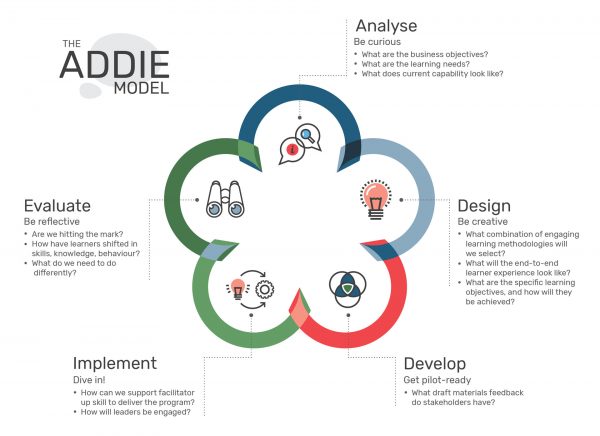
The Analysis Phase: Pinpointing instructional problems and learner needs within the ADDIE model.
The Analysis Phase is a critical stage in instructional design, laying the groundwork for learning experiences that are both effective and successful. This phase involves collecting and analysing data to gain a better understanding of the instructional problem, to define instructional goals, and to ascertain the learners' existing knowledge and skills.
During the Analysis Phase, the instructional problem is carefully considered to ensure a clear understanding of what issues need to be addressed.
This entails identifying any performance gaps or challenges that learners may be experiencing. In addition, the goals and objectives of the instruction are established, outlining what learners should be able to achieve by the end of the training or instruction.
Moreover, the learning environment and the learners are assessed during this phase. This assessment includes considering elements such as technological requirements, available resources, and learner characteristics, such as their existing knowledge and skills.
Key questions usually addressed during the Analysis Phase include:
- What instructional problem needs resolving?
- What are the intended goals and objectives of the instruction?
- What is the current level of the learners' knowledge and skills?
- What is the learning environment like?
By thoroughly exploring these questions and performing a comprehensive analysis, instructional designers can establish a firm foundation for designing and developing learning experiences that are both effective and tailored.
This phase provides the basis for subsequent phases of the instructional design process, such as the Design Phase and the Development Phase.
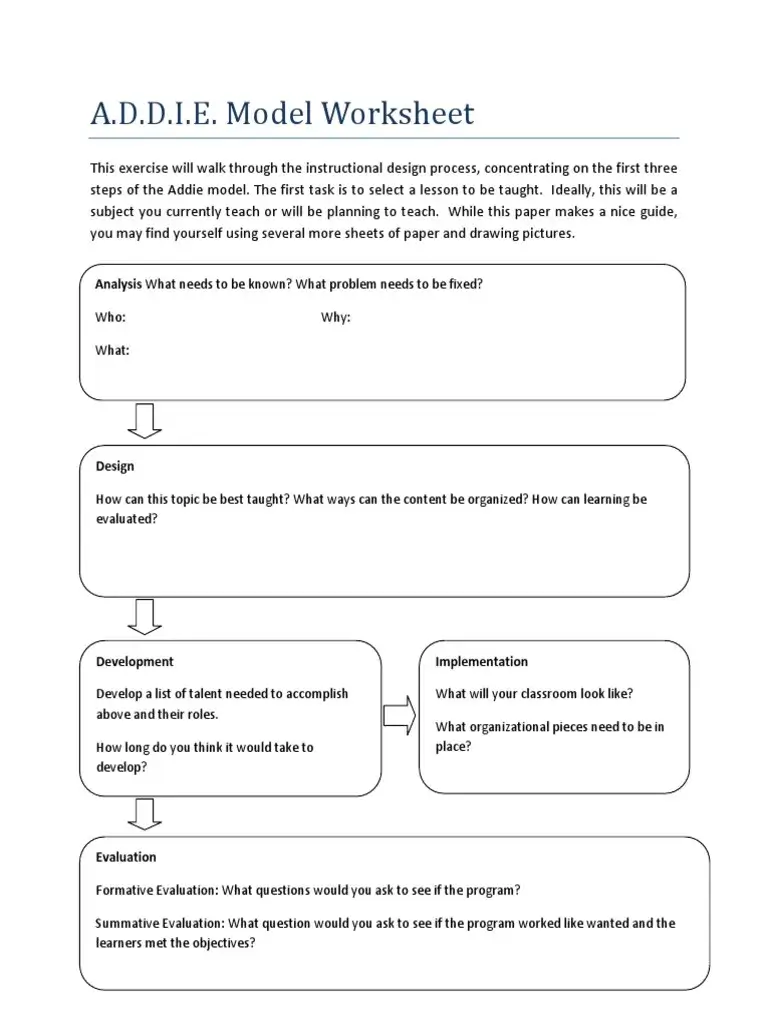
The Design Phase: Developing detailed instructional plans for ADDIE model implementation.
The Design Phase of the ADDIE model concentrates on developing a detailed plan for the instruction or training programme. This phase comprises several key actions that contribute to the creation of an effective and engaging instructional design.
One vital action in the Design Phase is documenting the instructional design strategy. This entails identifying and establishing clear learning objectives that outline what learners should achieve after completing the instruction. The design team also analyses the subject matter and conducts a comprehensive content analysis to ensure the content is relevant and aligned with the instructional goals.
Another action in this phase is applying instructional strategies. The design team identifies and selects appropriate instructional methods and techniques that align with the learning objectives and learner needs. They also design assessments and evaluation methods to measure learner progress and ensure the instruction's effectiveness.
Creating storyboards and prototypes is another key action in the Design Phase. Storyboards offer a visual representation of the sequence of content and activities within the instructional programme. Prototypes act as working models or drafts that enable testing and refinement before the instruction is actually delivered.
Furthermore, visual design plays an important role in this phase. Designers create a learning environment that is visually appealing and engaging by selecting appropriate graphics, multimedia elements, and visual prompts that enhance learners' understanding and retention of the content.
Overall, the Design Phase of the ADDIE model is a critical stage in which the instructional design strategy is documented, instructional strategies are applied, storyboards and prototypes are created, and visual design elements are incorporated to create an effective and engaging learning experience.
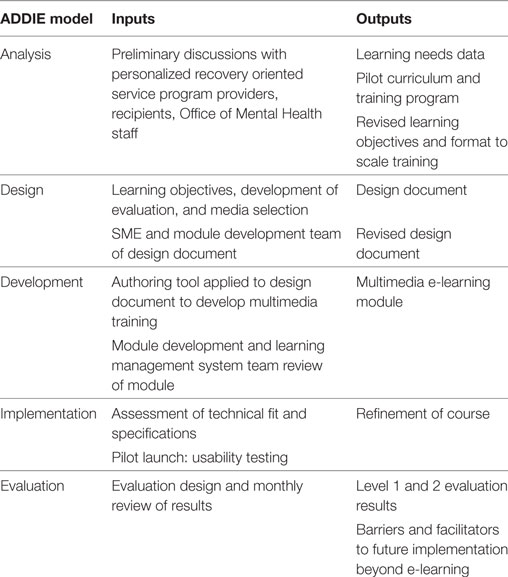
The Development Phase: Building content assets for effective ADDIE model instruction.
The Development Phase of the ADDIE model builds upon the basis established during the Design Phase and focuses on creating and assembling the content assets required for the instruction. This phase involves developing technologies, materials, and resources to support the learning objectives established in the preceding phase.
Collaboration with a design team is essential during the Development Phase. The design team liaises with subject matter experts and instructional designers to ensure that the instructional materials are accurate, comprehensive, and aligned with the instructional goals. By working together, the team can leverage their expertise to create effective and engaging learning experiences.
Additionally, reviewing materials and deadlines is vital during this phase. The design team must thoroughly review the instructional materials to ensure they meet the established learning objectives. It is also important to adhere to project deadlines to ensure the timely completion of the development process.
Another critical element of the Development Phase is testing and debugging. Instructional materials, technologies, and resources are subjected to rigorous testing to identify and fix any issues or errors. This iterative process ensures that the instruction functions smoothly and effectively before it is delivered to learners.
The Development Phase of the ADDIE model is a collaborative and iterative process that involves creating and assembling content assets, developing technologies, and performing testing and debugging procedures. By working closely with a design team and prioritising the review of materials and deadlines, instructional designers can develop high-quality instructional materials that effectively facilitate learning.
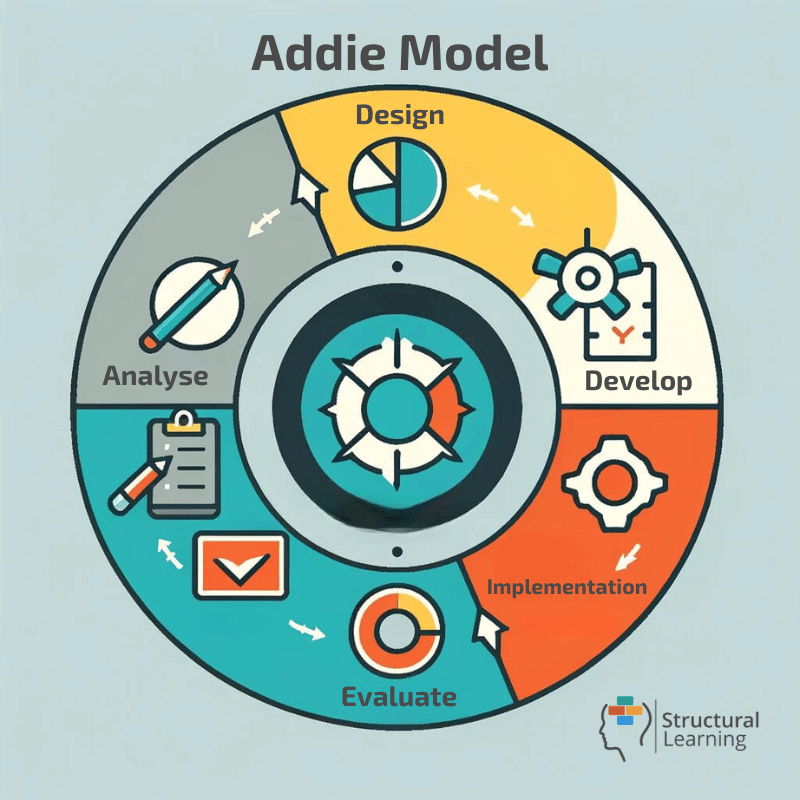
The Implementation Phase: Best practices for ADDIE model delivery and instruction.
The Implementation Phase is a critical step in the ADDIE model of instructional design. During this phase, several key actions and considerations must be addressed to ensure the successful delivery of instructional materials and achieve the intended learning outcomes.
Firstly, training facilitators or instructors is of utmost importance; they play a key role in effectively delivering the instruction to learners. Facilitators should have a comprehensive understanding of the content and instructional strategies, as well as the ability to engage and support learners throughout the learning process. Providing them with comprehensive training and guidance ensures they are equipped with the skills necessary to successfully facilitate the instruction.
Another critical consideration during the Implementation Phase is ensuring access to required materials and tools. This includes providing learners with all the necessary learning resources, such as textbooks, online materials, or multimedia resources.
Additionally, appropriate tools and technology, like learning management systems or virtual classrooms, should be used to enhance the learning experience and promote communication and collaboration.
Furthermore, documenting learner performance is essential during the Implementation Phase. It allows for the assessment of instructional effectiveness and provides valuable feedback for continuous improvement. By documenting learner performance, instructional designers can identify any gaps in understanding, modify the instruction if necessary, and provide additional support to learners as needed.
In summary, the successful Implementation Phase of the ADDIE model involves training facilitators, ensuring access to necessary materials and tools, and documenting learner performance. These considerations are essential to facilitate effective delivery of instruction and to achieve the intended learning outcomes.
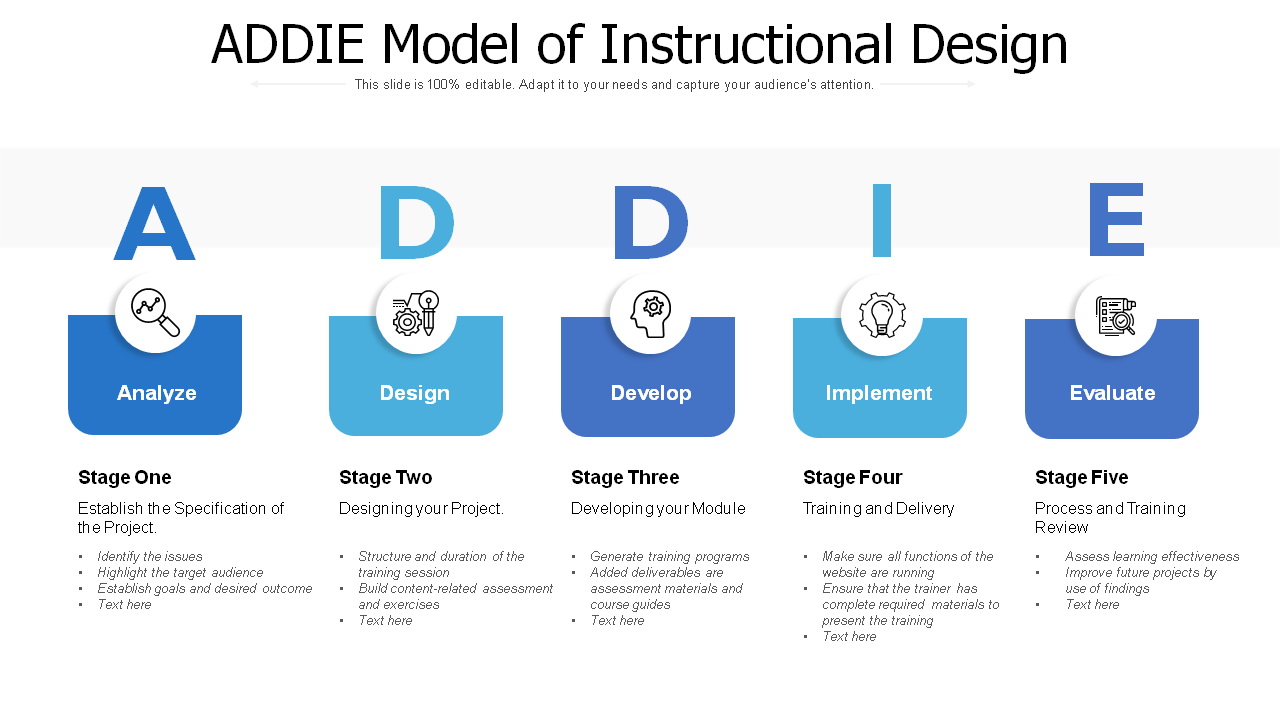
The Evaluation Phase: Assessing effectiveness and outcomes in the ADDIE model.
The evaluation phase is a critical component of the ADDIE instructional design model; it involves both formative and summative evaluations to assess the effectiveness of the instruction and measure learner outcomes.
Formative evaluation takes place throughout the instructional design process and focuses on gathering feedback and making improvements. This evaluation helps identify any weaknesses or areas for improvement in the instruction.
It can involve collecting data through observations, surveys, or interviews with learners, instructors, and other stakeholders. This feedback allows instructional designers to make necessary adjustments to the instructional materials and strategies to enhance the learning experience.
Summative evaluation, however, takes place at the end of the instruction to assess the overall success of the programme and its impact on learners.
This evaluation involves measuring the achievement of learning outcomes and determining the instruction's effectiveness. Assessments are used to measure learner performance and determine whether the learning objectives have been met.
These assessments can take various forms, including quizzes, tests, projects, or presentations. The results of the summative evaluation help determine the overall success of the instruction and provide insights for future improvements.
Continuous evaluation throughout the process is vital because it ensures that the instruction meets its intended goals and objectives.
Regular assessments allow for monitoring learner progress, identifying knowledge gaps, and making any necessary adjustments to the instruction. This continuous evaluation helps maintain instructional effectiveness and supports the achievement of desired learning outcomes.
During the summative evaluation phase, several key questions and considerations can guide the assessment process. These include:
1. Did the instruction effectively address the problem or topic it was designed for?
2. Did the learners successfully achieve the intended learning goals and outcomes?
3. How receptive were the learners to the instruction? Did it engage them effectively?
4. Are there any areas of the content or instructional materials that need to be revised or improved?
5. What are the specific areas for improvement in future iterations of the instruction?
By addressing these questions and considerations, instructional designers can gather valuable insights into the instruction's effectiveness and make informed decisions for future improvements. The evaluation phase ensures that the instruction aligns with its goals and objectives, and ultimately leads to the desired learning outcomes.
The ADDIE model is a commonly used instructional design framework that offers a systematic method for designing and developing training programmes. This model comprises five phases: analysis, design, development, implementation, and evaluation. The systematic nature of the ADDIE model offers several benefits.
Firstly, the ADDIE model assists in identifying best practice principles for instructional programmes. By following this model, instructional designers can ensure their courses are designed using proven methodologies and industry standards. This facilitates the creation of high-quality training courses that meet learners' needs.
Secondly, the ADDIE model simplifies the design of clear and specific learning objectives and materials. During the design phase, instructional designers can define the intended outcomes and specify appropriate instructional strategies and assessment methods to achieve those outcomes. This ensures the training materials align with the overall instructional goals and objectives.
Thirdly, the ADDIE process's evaluation phase allows for measurable outcomes. By conducting formative and summative evaluations, instructional designers can assess the effectiveness of the training programme and make any necessary improvements. This helps in continuously improving the quality of the training and ensuring the desired learning outcomes are achieved.
To summarise, the ADDIE model offers benefits such as identifying best practice principles, facilitating high-quality course design, and measuring the training programme's outcomes. By following this systematic approach, instructional designers can create effective and engaging instructional materials that meet the needs of learners.
The ADDIE Model: Addressing disadvantages for effective implementation.
While the ADDIE model is widely used and highly regarded in instructional design, it has disadvantages that merit consideration. One significant disadvantage is its linear process, which may not adequately accommodate complex learning needs.
The model adheres to a sequential order of analysis, design, development, implementation, and evaluation, which may lack the flexibility needed for unique learning situations that require a more iterative approach.
Another disadvantage lies in the resource-intensive nature of the ADDIE model, which can pose challenges for smaller organisations with limited budgets and staffing.
The model requires considerable time and financial investments, including the involvement of a dedicated instructional design team, the development of instructional materials, and the implementation of evaluation measures. This can be a barrier for organisations with limited resources, ultimately restricting their ability to effectively implement the ADDIE model.
In addition, the ADDIE model has been criticised for its insufficient focus on user experience. Although the model focuses on designing clear learning objectives and effective instructional strategies, it may not sufficiently prioritise creating engaging and interactive instruction. Instructional materials developed using the ADDIE model can be uninteresting and unengaging, which can reduce learner motivation and learning outcomes.
While the ADDIE model offers a systematic and structured approach to instructional design, it is important to recognise its disadvantages. Its linear process may not accommodate complex learning needs, it is resource-intensive, which may make it unfeasible for smaller organisations, and it may not sufficiently prioritise creating engaging instruction.
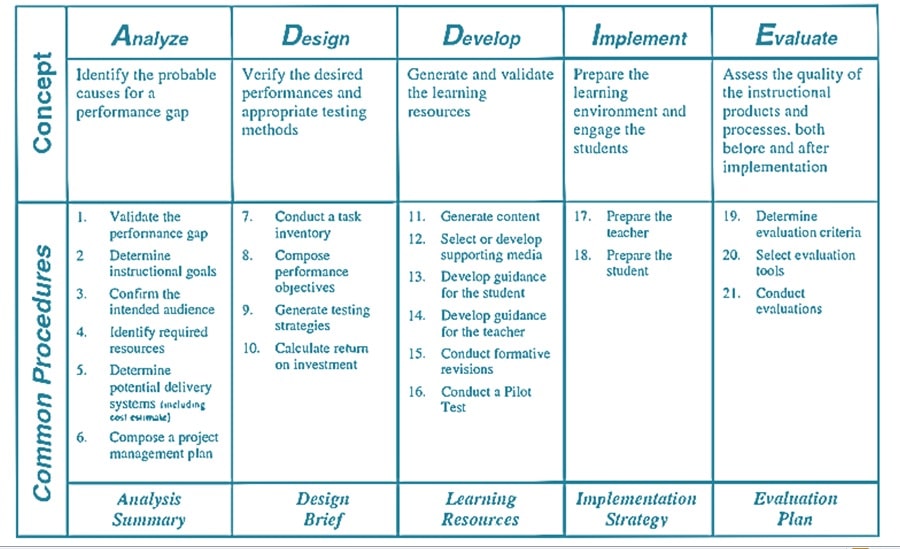
Here are three examples of its unique application.
Firstly, in medical education, the ADDIE model was used to develop a curriculum for teaching chest radiograph interpretation to internal medicine residents. The model provided a systematic approach to ensure the curriculum met learners' needs, leading to improved diagnostic and management skills for respiratory diseases.
Secondly, the model was employed to design a professional development programme for primary care physicians in Saudi Arabia. The ADDIE model guided the creation of interactive sessions based on the physicians' learning needs. Despite lower-than-expected scores on the final knowledge assessment, at least 50% of participants reported "great" improvement in their learning for 16 out of 23 topics.
Finally, the ADDIE model was used to adapt a traditionally face-to-face course, Programming Languages-I, into a fully-online course. The course design took approximately 500 hours, and a pilot application was carried out after its completion. Learner feedback and the results of a usability test led to revisions and improvements in the course design.
As educational technology expert Jane Bozarth once said, "Instructional design is not just about creating content; it's about creating experiences that facilitate learning." Indeed, the ADDIE model is a useful tool that can transform the learning experience, making it more effective and engaging.
In fact, a study found that students who learned through an interactive lesson designed using the ADDIE model showed a statistically significant improvement in performance, with a mean score of 5.45, compared to 4.24 for those who learned through traditional methods.
The ADDIE model can be a useful tool when applied in your organisation. Here are seven practical guidelines to maximise its potential.
Adopting the ADDIE model in your institution can be a transformative step towards creating more effective and engaging learning experiences.
Remember that the journey of instructional design is not always linear, and it's acceptable to iterate and refine as you progress. The ADDIE model is not a rigid framework but a flexible guide that can be tailored to your unique context and needs. A
As you embark on this journey, remain open to learning and adapting. The rewards of improved learner engagement and outcomes will be worthwhile.

The effectiveness of the ADDIE model, a leading instructional design framework, has been thoroughly examined in various studies. These studies have focused particularly on its application in training developers, refining delivery methods, and improving the user interface in educational contexts. Here's an expanded analysis of recent papers exploring this concept:
1. Enhancing Training Developers' Skills: The study titled "The Effects of Instructional Training on University Teaching Assistants" (2008) by P. Hardré shows how the ADDIE model serves as a key element in training developers, particularly in university settings. By focusing on lesson planning and authoring tools,
The ADDIE model is a well-known instructional design framework, offering a systematic and structured method for developing effective training and educational programmes. Comprising five interconnected phases; Analysis, Design, Development, Implementation, and Evaluation, the model ensures instructional materials are carefully planned, executed, and improved for maximum effect. As we head into 2025, this model remains a cornerstone of effective instructional strategies. By guiding educators and trainers through each phase, ADDIE supports the creation of high-quality learning experiences that are tailored to specific goals and audiences.
Originally conceived in the 1970s at Florida State University for the U.S. military, the ADDIE model sought to establish consistent training methods across the armed forces. Its versatility and precision have since established it as a key tool in various educational and corporate settings. Each phase has a clear purpose, from analysing learner needs and designing effective strategies, to developing resources, implementing solutions, and evaluating success. Together, these phases create a cycle of continuous improvement, ensuring that learning programmes are both efficient and impactful.
In this article, we will examine each phase of the ADDIE model, consider its practical uses in education and training, and provide guidance on how teachers and instructional designers can use it to optimise their learning programmes.
The ADDIE model incorporates five primary phases: Analysis, Design, Development, Implementation, and Evaluation. Each phase is key to the structured method of developing effective training and educational programmes.
The first phase, Analysis, includes gathering data about the learners, their specific needs, and the context of learning. This process helps in determining goals, objectives, and identifying any gaps in performance.
Based on the analysis, the Design phase concentrates on establishing instructional goals, learning objectives, and strategies, while also identifying suitable instructional methods, content, and assessment tools.
The Development phase is where instructional materials and resources are actually developed, including creating lesson plans and designing training materials. The fourth phase, Implementation, involves delivering the training programme or educational course, ensuring the designed materials and strategies are effectively used in practice.
Finally, the Evaluation phase assesses the effectiveness of the instruction through formative evaluation during development and summative evaluation after implementation, thereby promoting continuous improvement.

The Analysis Phase: Pinpointing instructional problems and learner needs within the ADDIE model.
The Analysis Phase is a critical stage in instructional design, laying the groundwork for learning experiences that are both effective and successful. This phase involves collecting and analysing data to gain a better understanding of the instructional problem, to define instructional goals, and to ascertain the learners' existing knowledge and skills.
During the Analysis Phase, the instructional problem is carefully considered to ensure a clear understanding of what issues need to be addressed.
This entails identifying any performance gaps or challenges that learners may be experiencing. In addition, the goals and objectives of the instruction are established, outlining what learners should be able to achieve by the end of the training or instruction.
Moreover, the learning environment and the learners are assessed during this phase. This assessment includes considering elements such as technological requirements, available resources, and learner characteristics, such as their existing knowledge and skills.
Key questions usually addressed during the Analysis Phase include:
- What instructional problem needs resolving?
- What are the intended goals and objectives of the instruction?
- What is the current level of the learners' knowledge and skills?
- What is the learning environment like?
By thoroughly exploring these questions and performing a comprehensive analysis, instructional designers can establish a firm foundation for designing and developing learning experiences that are both effective and tailored.
This phase provides the basis for subsequent phases of the instructional design process, such as the Design Phase and the Development Phase.

The Design Phase: Developing detailed instructional plans for ADDIE model implementation.
The Design Phase of the ADDIE model concentrates on developing a detailed plan for the instruction or training programme. This phase comprises several key actions that contribute to the creation of an effective and engaging instructional design.
One vital action in the Design Phase is documenting the instructional design strategy. This entails identifying and establishing clear learning objectives that outline what learners should achieve after completing the instruction. The design team also analyses the subject matter and conducts a comprehensive content analysis to ensure the content is relevant and aligned with the instructional goals.
Another action in this phase is applying instructional strategies. The design team identifies and selects appropriate instructional methods and techniques that align with the learning objectives and learner needs. They also design assessments and evaluation methods to measure learner progress and ensure the instruction's effectiveness.
Creating storyboards and prototypes is another key action in the Design Phase. Storyboards offer a visual representation of the sequence of content and activities within the instructional programme. Prototypes act as working models or drafts that enable testing and refinement before the instruction is actually delivered.
Furthermore, visual design plays an important role in this phase. Designers create a learning environment that is visually appealing and engaging by selecting appropriate graphics, multimedia elements, and visual prompts that enhance learners' understanding and retention of the content.
Overall, the Design Phase of the ADDIE model is a critical stage in which the instructional design strategy is documented, instructional strategies are applied, storyboards and prototypes are created, and visual design elements are incorporated to create an effective and engaging learning experience.

The Development Phase: Building content assets for effective ADDIE model instruction.
The Development Phase of the ADDIE model builds upon the basis established during the Design Phase and focuses on creating and assembling the content assets required for the instruction. This phase involves developing technologies, materials, and resources to support the learning objectives established in the preceding phase.
Collaboration with a design team is essential during the Development Phase. The design team liaises with subject matter experts and instructional designers to ensure that the instructional materials are accurate, comprehensive, and aligned with the instructional goals. By working together, the team can leverage their expertise to create effective and engaging learning experiences.
Additionally, reviewing materials and deadlines is vital during this phase. The design team must thoroughly review the instructional materials to ensure they meet the established learning objectives. It is also important to adhere to project deadlines to ensure the timely completion of the development process.
Another critical element of the Development Phase is testing and debugging. Instructional materials, technologies, and resources are subjected to rigorous testing to identify and fix any issues or errors. This iterative process ensures that the instruction functions smoothly and effectively before it is delivered to learners.
The Development Phase of the ADDIE model is a collaborative and iterative process that involves creating and assembling content assets, developing technologies, and performing testing and debugging procedures. By working closely with a design team and prioritising the review of materials and deadlines, instructional designers can develop high-quality instructional materials that effectively facilitate learning.

The Implementation Phase: Best practices for ADDIE model delivery and instruction.
The Implementation Phase is a critical step in the ADDIE model of instructional design. During this phase, several key actions and considerations must be addressed to ensure the successful delivery of instructional materials and achieve the intended learning outcomes.
Firstly, training facilitators or instructors is of utmost importance; they play a key role in effectively delivering the instruction to learners. Facilitators should have a comprehensive understanding of the content and instructional strategies, as well as the ability to engage and support learners throughout the learning process. Providing them with comprehensive training and guidance ensures they are equipped with the skills necessary to successfully facilitate the instruction.
Another critical consideration during the Implementation Phase is ensuring access to required materials and tools. This includes providing learners with all the necessary learning resources, such as textbooks, online materials, or multimedia resources.
Additionally, appropriate tools and technology, like learning management systems or virtual classrooms, should be used to enhance the learning experience and promote communication and collaboration.
Furthermore, documenting learner performance is essential during the Implementation Phase. It allows for the assessment of instructional effectiveness and provides valuable feedback for continuous improvement. By documenting learner performance, instructional designers can identify any gaps in understanding, modify the instruction if necessary, and provide additional support to learners as needed.
In summary, the successful Implementation Phase of the ADDIE model involves training facilitators, ensuring access to necessary materials and tools, and documenting learner performance. These considerations are essential to facilitate effective delivery of instruction and to achieve the intended learning outcomes.

The Evaluation Phase: Assessing effectiveness and outcomes in the ADDIE model.
The evaluation phase is a critical component of the ADDIE instructional design model; it involves both formative and summative evaluations to assess the effectiveness of the instruction and measure learner outcomes.
Formative evaluation takes place throughout the instructional design process and focuses on gathering feedback and making improvements. This evaluation helps identify any weaknesses or areas for improvement in the instruction.
It can involve collecting data through observations, surveys, or interviews with learners, instructors, and other stakeholders. This feedback allows instructional designers to make necessary adjustments to the instructional materials and strategies to enhance the learning experience.
Summative evaluation, however, takes place at the end of the instruction to assess the overall success of the programme and its impact on learners.
This evaluation involves measuring the achievement of learning outcomes and determining the instruction's effectiveness. Assessments are used to measure learner performance and determine whether the learning objectives have been met.
These assessments can take various forms, including quizzes, tests, projects, or presentations. The results of the summative evaluation help determine the overall success of the instruction and provide insights for future improvements.
Continuous evaluation throughout the process is vital because it ensures that the instruction meets its intended goals and objectives.
Regular assessments allow for monitoring learner progress, identifying knowledge gaps, and making any necessary adjustments to the instruction. This continuous evaluation helps maintain instructional effectiveness and supports the achievement of desired learning outcomes.
During the summative evaluation phase, several key questions and considerations can guide the assessment process. These include:
1. Did the instruction effectively address the problem or topic it was designed for?
2. Did the learners successfully achieve the intended learning goals and outcomes?
3. How receptive were the learners to the instruction? Did it engage them effectively?
4. Are there any areas of the content or instructional materials that need to be revised or improved?
5. What are the specific areas for improvement in future iterations of the instruction?
By addressing these questions and considerations, instructional designers can gather valuable insights into the instruction's effectiveness and make informed decisions for future improvements. The evaluation phase ensures that the instruction aligns with its goals and objectives, and ultimately leads to the desired learning outcomes.
The ADDIE model is a commonly used instructional design framework that offers a systematic method for designing and developing training programmes. This model comprises five phases: analysis, design, development, implementation, and evaluation. The systematic nature of the ADDIE model offers several benefits.
Firstly, the ADDIE model assists in identifying best practice principles for instructional programmes. By following this model, instructional designers can ensure their courses are designed using proven methodologies and industry standards. This facilitates the creation of high-quality training courses that meet learners' needs.
Secondly, the ADDIE model simplifies the design of clear and specific learning objectives and materials. During the design phase, instructional designers can define the intended outcomes and specify appropriate instructional strategies and assessment methods to achieve those outcomes. This ensures the training materials align with the overall instructional goals and objectives.
Thirdly, the ADDIE process's evaluation phase allows for measurable outcomes. By conducting formative and summative evaluations, instructional designers can assess the effectiveness of the training programme and make any necessary improvements. This helps in continuously improving the quality of the training and ensuring the desired learning outcomes are achieved.
To summarise, the ADDIE model offers benefits such as identifying best practice principles, facilitating high-quality course design, and measuring the training programme's outcomes. By following this systematic approach, instructional designers can create effective and engaging instructional materials that meet the needs of learners.
The ADDIE Model: Addressing disadvantages for effective implementation.
While the ADDIE model is widely used and highly regarded in instructional design, it has disadvantages that merit consideration. One significant disadvantage is its linear process, which may not adequately accommodate complex learning needs.
The model adheres to a sequential order of analysis, design, development, implementation, and evaluation, which may lack the flexibility needed for unique learning situations that require a more iterative approach.
Another disadvantage lies in the resource-intensive nature of the ADDIE model, which can pose challenges for smaller organisations with limited budgets and staffing.
The model requires considerable time and financial investments, including the involvement of a dedicated instructional design team, the development of instructional materials, and the implementation of evaluation measures. This can be a barrier for organisations with limited resources, ultimately restricting their ability to effectively implement the ADDIE model.
In addition, the ADDIE model has been criticised for its insufficient focus on user experience. Although the model focuses on designing clear learning objectives and effective instructional strategies, it may not sufficiently prioritise creating engaging and interactive instruction. Instructional materials developed using the ADDIE model can be uninteresting and unengaging, which can reduce learner motivation and learning outcomes.
While the ADDIE model offers a systematic and structured approach to instructional design, it is important to recognise its disadvantages. Its linear process may not accommodate complex learning needs, it is resource-intensive, which may make it unfeasible for smaller organisations, and it may not sufficiently prioritise creating engaging instruction.

Here are three examples of its unique application.
Firstly, in medical education, the ADDIE model was used to develop a curriculum for teaching chest radiograph interpretation to internal medicine residents. The model provided a systematic approach to ensure the curriculum met learners' needs, leading to improved diagnostic and management skills for respiratory diseases.
Secondly, the model was employed to design a professional development programme for primary care physicians in Saudi Arabia. The ADDIE model guided the creation of interactive sessions based on the physicians' learning needs. Despite lower-than-expected scores on the final knowledge assessment, at least 50% of participants reported "great" improvement in their learning for 16 out of 23 topics.
Finally, the ADDIE model was used to adapt a traditionally face-to-face course, Programming Languages-I, into a fully-online course. The course design took approximately 500 hours, and a pilot application was carried out after its completion. Learner feedback and the results of a usability test led to revisions and improvements in the course design.
As educational technology expert Jane Bozarth once said, "Instructional design is not just about creating content; it's about creating experiences that facilitate learning." Indeed, the ADDIE model is a useful tool that can transform the learning experience, making it more effective and engaging.
In fact, a study found that students who learned through an interactive lesson designed using the ADDIE model showed a statistically significant improvement in performance, with a mean score of 5.45, compared to 4.24 for those who learned through traditional methods.
The ADDIE model can be a useful tool when applied in your organisation. Here are seven practical guidelines to maximise its potential.
Adopting the ADDIE model in your institution can be a transformative step towards creating more effective and engaging learning experiences.
Remember that the journey of instructional design is not always linear, and it's acceptable to iterate and refine as you progress. The ADDIE model is not a rigid framework but a flexible guide that can be tailored to your unique context and needs. A
As you embark on this journey, remain open to learning and adapting. The rewards of improved learner engagement and outcomes will be worthwhile.

The effectiveness of the ADDIE model, a leading instructional design framework, has been thoroughly examined in various studies. These studies have focused particularly on its application in training developers, refining delivery methods, and improving the user interface in educational contexts. Here's an expanded analysis of recent papers exploring this concept:
1. Enhancing Training Developers' Skills: The study titled "The Effects of Instructional Training on University Teaching Assistants" (2008) by P. Hardré shows how the ADDIE model serves as a key element in training developers, particularly in university settings. By focusing on lesson planning and authoring tools,